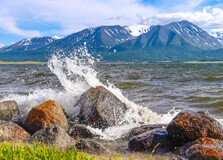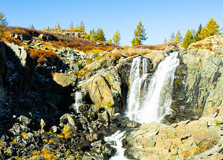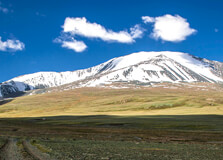
- Home
- Travel Packages
- Top Destination
-
Travel Attraction
By Category
Top Attraction

- Travel Agents
- Car Rentals
- Hotels

Khoton Lake is a pristine alpine lake located in the western part of Mongolia, near the town of Olgii in Bayan-Ölgii Province. Nestled within the Altai Tavan Bogd National Park, Khoton Lake is one of the largest and most beautiful freshwater lakes in Mongolia. Surrounded by towering mountains, glaciers, and lush valleys, the lake is a true natural gem offering breathtaking scenery and a peaceful retreat from the modern world. The lake is known for its crystal-clear waters, rich biodiversity, and the unique traditional lifestyle of the Kazakh nomadic people living nearby. It is an ideal destination for travelers interested in nature, culture, and adventure in a remote and unspoiled environment. How to Reach Khoton Lake Khoton Lake is located approximately 240 kilometers southwest of Olgii town. Due to its remote location, reaching Khoton Lake requires some planning and preparation: From Olgii: The most common route is to travel by 4x4 vehicle or join a guided tour from Olgii. The journey can take 6 to 8 hours on rugged mountain roads, depending on weather and road conditions. Travel Arrangements: Hiring a local guide and driver is highly recommended for safety and ease of navigation. The road to the lake passes through mountainous terrain and sometimes difficult weather conditions. By Trekking or Horseback: For the adventurous, parts of the route can be explored on foot or horseback, but this requires excellent physical condition and experience in mountain travel. Weather at Khoton Lake Khoton Lake is located in a high-altitude alpine environment, meaning the weather can be quite variable and sometimes harsh. Summer (June to August): Mild and pleasant temperatures ranging from 10°C to 20°C during the day, with cool nights. This is the best time to visit as the roads are more accessible and the weather is stable. Autumn (September to October): Cooler weather with temperatures dropping quickly, especially at night. The area’s autumn colors create a stunning landscape, but early snowfall may start to appear. Winter (November to February): Extremely cold with temperatures often below -30°C. The lake may freeze over, and heavy snow makes travel very difficult. Spring (March to May): Variable weather with melting snow and muddy roads, making travel more challenging. Timing to Visit Khoton Lake The ideal visiting season is between June and early September when the weather is warmer, and the landscape is accessible. During these months, visitors can enjoy trekking, camping, fishing, and exploring the lake’s surroundings safely. Visiting outside this period is not impossible but requires careful preparation for cold temperatures and potentially hazardous road conditions. Why is Khoton Lake Famous? Khoton Lake is famous for its stunning natural beauty and ecological importance. The lake is fed by glacier meltwaters from the surrounding Altai Mountains, resulting in remarkably clear and cold water. It supports a diverse range of aquatic life, including native fish species such as the endemic Altai osman and lenok trout. Apart from its ecological significance, Khoton Lake is well-known for its cultural heritage. The Kazakh nomads who inhabit the area live a traditional pastoral lifestyle, maintaining ancient customs and practices that visitors can experience firsthand. The lake and its environment symbolize the harmonious relationship between nature and nomadic culture in Mongolia. Entry and Visit Details Khoton Lake lies within Altai Tavan Bogd National Park, and visitors must adhere to park regulations and entry requirements. Entry Permits: Required for all visitors to the national park, including Khoton Lake. These are typically arranged through tour operators or local park authorities in Olgii. Guided Visits: Highly recommended due to the remote location and difficult terrain. Local guides offer valuable knowledge about the environment, wildlife, and culture. Accommodation: Limited options near the lake, mostly traditional nomadic gers or camping sites. It’s advisable to plan overnight stays in advance. Respecting Nature: Visitors should follow Leave No Trace principles, avoid disturbing wildlife, and respect local customs. History and Architecture While Khoton Lake itself does not have architectural structures, the surrounding area is steeped in history. The region is home to ancient petroglyphs and burial sites that reveal the presence of early nomadic tribes. The traditional architecture of the Kazakh people is visible in their use of portable gers (yurts). These round felt tents are practical, sustainable, and perfectly suited to the nomadic lifestyle. Staying in a ger near Khoton Lake offers visitors an authentic cultural experience. Things to Do at Khoton Lake Trekking: Explore the stunning mountain trails around the lake, including routes leading to glaciers and alpine meadows. Fishing: The lake is a great spot for fishing native trout and osman, with local guides providing equipment and tips. Wildlife Watching: Spot marmots, mountain goats, birds, and occasionally elusive snow leopards in the surrounding areas. Cultural Experiences: Visit Kazakh nomadic families, learn about their traditions, watch eagle hunting demonstrations, and participate in local festivals. Camping and Photography: The pristine environment and dramatic landscapes offer excellent opportunities for camping and photography. Facts and Tips about Khoton Lake Khoton Lake is the second-largest alpine lake in Mongolia and part of a UNESCO World Heritage Site. The lake is fed by glaciers from the nearby Altai Mountains, which are rapidly retreating due to climate change. Visitors should bring warm clothing even in summer due to cool mountain temperatures. Altitude can affect visitors; take it slow and stay hydrated to avoid altitude sickness. Respect local customs and ask permission before photographing people or their homes. Food and supplies are limited near the lake, so bring necessary provisions from Olgii. Hire local guides to ensure safety and enrich your experience with their knowledge. Khoton Lake offers an unforgettable blend of natural splendor and cultural richness. It is an ideal destination for travelers who want to connect with Mongolia’s wild landscapes and experience the timeless traditions of the Kazakh nomads. Whether you seek adventure, tranquility, or cultural immersion, Khoton Lake is a remarkable place to explore.
Explore More
Baga Turgen Waterfall is a stunning natural attraction located in the western region of Mongolia, in Bayan-Ölgii Province. Nestled within the Altai Tavan Bogd National Park, the waterfall lies near the border with China and is surrounded by dramatic mountain scenery, lush valleys, and alpine meadows. Baga Turgen translates to "Small Turgen," and despite its name, the waterfall is impressive in both beauty and force. This remote and serene spot is one of the hidden gems of Mongolia, offering a perfect mix of adventure, nature, and peace. It's an ideal destination for those seeking a break from city life and who want to explore Mongolia’s untouched landscapes. How to Reach Baga Turgen Waterfall Due to its location deep within Altai Tavan Bogd National Park, reaching Baga Turgen Waterfall takes some effort but is well worth it. From Ulaanbaatar to Olgii: Take a domestic flight from Ulaanbaatar to Olgii, the capital of Bayan-Ölgii Province. The flight takes about 2–3 hours. From Olgii to Baga Turgen: From Olgii, you will need to travel by 4x4 vehicle, typically as part of a guided tour. The drive can take 6–8 hours depending on road and weather conditions. The final part of the journey may require hiking or horseback riding, depending on the terrain. Local Guides: Due to the remote and rugged nature of the area, it’s strongly advised to hire a local guide and driver who know the terrain and can help navigate the unmarked trails. Weather at Baga Turgen Waterfall The weather around Baga Turgen Waterfall varies significantly throughout the year due to its high elevation and mountainous setting. Summer (June to August): The best time to visit. Daytime temperatures range from 10°C to 20°C. Expect occasional rain showers and cool nights. Autumn (September to October): Cooler temperatures and fewer tourists. The landscape becomes colorful with fall foliage, but nighttime temperatures can drop below freezing. Winter (November to March): Extremely cold, with heavy snow. Temperatures can fall below -30°C, making the area inaccessible to most tourists. Spring (April to May): Melting snow can make the area muddy and difficult to access. Roads are often in poor condition. Timing to Visit Baga Turgen Waterfall The best time to visit Baga Turgen Waterfall is between June and early September. During these months, the weather is relatively warm, the waterfall flows at full strength, and the surrounding nature is green and lush. It’s recommended to start your day early, as travel times are long, and you’ll want to enjoy enough time at the site before heading back or setting up camp nearby. Why is Baga Turgen Waterfall Famous? Baga Turgen Waterfall is famous for its unspoiled beauty and remote location. The waterfall, which drops around 10–12 meters in two stages, is surrounded by pine forests and dramatic mountain landscapes, making it an ideal spot for photographers and nature lovers. The area is also known for its rich biodiversity and connection to local Kazakh nomadic culture. Since it's located near the border, the region is less frequented by tourists, adding to its appeal for those seeking solitude and authentic nature experiences. Entry and Visit Details Baga Turgen Waterfall is within the boundaries of Altai Tavan Bogd National Park, and all visitors must comply with the park’s entry regulations. Entry Permit: Required to access the national park. You can get it through local travel agencies or park offices in Olgii. Guided Tours: Strongly recommended due to the area’s remoteness and the lack of marked paths. Fees: Park entrance fees are minimal but may vary depending on the season and services offered by your tour provider. Border Permit: Since the waterfall is near the Chinese border, additional permits from the border control office may be required. Your guide can arrange this in advance. History and Local Significance While Baga Turgen Waterfall does not have historical monuments or built architecture, the region around it holds cultural and environmental importance. The nearby valleys and mountains have been inhabited for centuries by Kazakh nomads who continue to live in harmony with nature. Visitors to the area can witness traditional Kazakh herding practices, eagle hunting, and ger living. These nomadic communities maintain a deep respect for the land and its natural features, including the waterfall. Things to Do at Baga Turgen Waterfall Hiking: Enjoy scenic treks to and from the waterfall through forests and mountainous terrain. Photography: The waterfall, surrounding landscapes, and wildlife provide excellent photo opportunities. Picnicking: Relax near the waterfall and enjoy a peaceful meal in nature. Camping: Set up camp nearby and experience the calm of the Mongolian wilderness under the stars. Cultural Visits: Interact with local Kazakh herders and learn about their traditional lifestyles and hospitality. Birdwatching and Wildlife Spotting: The region is home to species like ibex, marmots, and a variety of birds including eagles and falcons. Facts and Tips about Baga Turgen Waterfall The waterfall is part of the Turgen River system, fed by glacial meltwaters from the Altai Mountains. “Baga” means “small” in Mongolian, while “Turgen” refers to the fast-flowing river the waterfall originates from. The surrounding area is home to one of Mongolia's largest populations of Kazakh nomads. There are no restaurants or shops nearby, so bring all necessary food, water, and camping gear. Always travel with a local guide or in a group for safety and guidance through the unmarked terrain. Respect local customs — dress modestly and ask before taking photos of people or their homes. There is no mobile signal near the waterfall, so inform someone of your travel plans beforehand. Baga Turgen Waterfall is a spectacular and remote destination that captures the true spirit of Mongolia's wild beauty. It offers a rare opportunity to connect with nature, experience authentic nomadic culture, and explore one of the country's most beautiful and untouched landscapes. Whether you're an adventurer, a photographer, or simply someone in search of peace and quiet, Baga Turgen Waterfall is a place that will leave you inspired and refreshed.
Explore More
Tsengel Khairkhan Mountain is one of the most sacred and picturesque peaks in western Mongolia. Located in Bayan-Ölgii Province near the small town of Tsengel, this majestic mountain is part of the Mongol Altai Range and reaches an elevation of around 3,943 meters (12,936 feet). "Khairkhan" means "sacred" in Mongolian, and the name reflects the deep spiritual and cultural significance the mountain holds for the local Kazakh and Tuvan communities. The mountain is known for its breathtaking alpine landscapes, glaciers, pristine rivers, and the nomadic traditions of the people who inhabit the surrounding valleys. It is a place where nature, spirituality, and history come together, making it an extraordinary destination for travelers who appreciate raw natural beauty and cultural heritage. How to Reach Tsengel Khairkhan Mountain Reaching Tsengel Khairkhan Mountain requires a combination of air and overland travel due to its remote location. Step 1 – Fly to Ölgii: Take a domestic flight from Ulaanbaatar, Mongolia’s capital, to Ölgii Airport. The flight usually takes about 2 to 3 hours. Step 2 – Drive to Tsengel Village: From Ölgii, hire a 4x4 vehicle or join a guided tour to reach Tsengel, a small town located about 100 kilometers southwest. The drive takes approximately 3–4 hours over rugged terrain. Step 3 – Trek or Ride to the Mountain: Depending on your destination point around the mountain, you may need to trek or ride on horseback to reach specific areas, as roads can be rough or non-existent near the base of the mountain. Local guides and tour agencies based in Ölgii can arrange the full trip, including permits, transportation, accommodation, and cultural experiences. Weather at Tsengel Khairkhan Mountain The climate around Tsengel Khairkhan is typical of high-altitude alpine environments, with cold winters and cool summers. Summer (June–August): Mild daytime temperatures between 10°C and 20°C, with colder nights. Ideal for trekking and exploring. Autumn (September–October): Cooler and drier weather with beautiful autumn colors, but nights can be below freezing. Winter (November–March): Harsh and extremely cold. Temperatures drop well below -25°C. Travel is not recommended during this time. Spring (April–May): Unpredictable weather with lingering snow and muddy conditions. Roads can be challenging. Best Time to Visit The best time to visit Tsengel Khairkhan Mountain is from late June to early September. During this period, the weather is most favorable for trekking, camping, and experiencing local culture. Wildflowers bloom in the meadows, and the mountain scenery is at its most beautiful. Early autumn is also a good time for those interested in photography, with clear skies and vibrant colors. Why is Tsengel Khairkhan Mountain Famous? Tsengel Khairkhan is famous for several reasons. Firstly, it is one of the sacred mountains in Mongolia and is revered by local Kazakhs and Tuvans, who often perform spiritual rituals near its slopes. Secondly, the mountain offers incredible views of the Altai range and is home to diverse flora and fauna, including rare species like the snow leopard, ibex, and golden eagle. It is also an excellent destination for trekking, eco-tourism, and cultural experiences, including visits to local eagle hunters and nomadic families. The blend of natural beauty and traditional life makes this a unique and memorable destination. Entry and Visit Details As Tsengel Khairkhan Mountain is in a border region and part of protected lands, visitors need specific permits and should respect local customs. Permits: Required to enter the border zone. These are usually arranged by tour operators or the local border control office in Ölgii. Guides: Hiring a local guide is strongly recommended for navigation, safety, and cultural interpretation. Fees: A small entry fee may apply for the park or cultural experiences. Be sure to confirm with your guide or agency. Accommodation: Options include staying in traditional Kazakh gers (yurts), camping, or guesthouses in Tsengel or Ölgii. History and Cultural Significance Tsengel Khairkhan has been considered a sacred mountain for generations. The local nomadic tribes believe the mountain is the dwelling place of powerful spirits and nature deities. Ceremonies and offerings are often made at its base during summer. In the nearby valleys, there are archaeological sites with ancient petroglyphs and burial mounds from the Scythian and Turkic periods, indicating a long history of human habitation and spiritual activity. The architecture is traditional, focused on mobile living structures such as gers, used by Kazakh herders for centuries. Things to Do at Tsengel Khairkhan Mountain Trekking: Explore the mountain's scenic trails and enjoy views of glaciers, rivers, and forests. Horseback Riding: Ride through traditional nomadic routes led by experienced Kazakh horsemen. Wildlife Watching: Spot rare animals like argali sheep, marmots, and birds of prey. Visit Nomadic Families: Learn about traditional lifestyles, taste local dairy products, and witness eagle hunting demonstrations. Photography: Capture the spectacular landscapes, cultural scenes, and star-filled night skies. Camping: Spend the night near the base of the mountain surrounded by silence and nature. Facts and Tips about Tsengel Khairkhan Mountain Tsengel Khairkhan is among the tallest sacred peaks in Mongolia’s western Altai region. The mountain is located near Mongolia’s border with China, requiring special permits for foreigners. The Kazakh community here is famous for their golden eagle hunting tradition — practiced for over 2,000 years. Altitude sickness is possible due to elevation — acclimatize gradually and stay hydrated. Bring warm clothes, even in summer, as temperatures can drop sharply at night. There are no ATMs or mobile signals near the mountain — carry cash and notify someone of your plans. Travel in groups or with guides for safety and cultural understanding. Respect local customs — do not climb sacred points without permission, and always ask before taking photos of people or ceremonies. Tsengel Khairkhan Mountain offers a rare combination of raw natural beauty, deep cultural heritage, and spiritual serenity. For travelers seeking more than just sightseeing — for those wanting to immerse themselves in the traditions of Mongolia’s western frontier — this mountain is an unforgettable destination.
Explore More